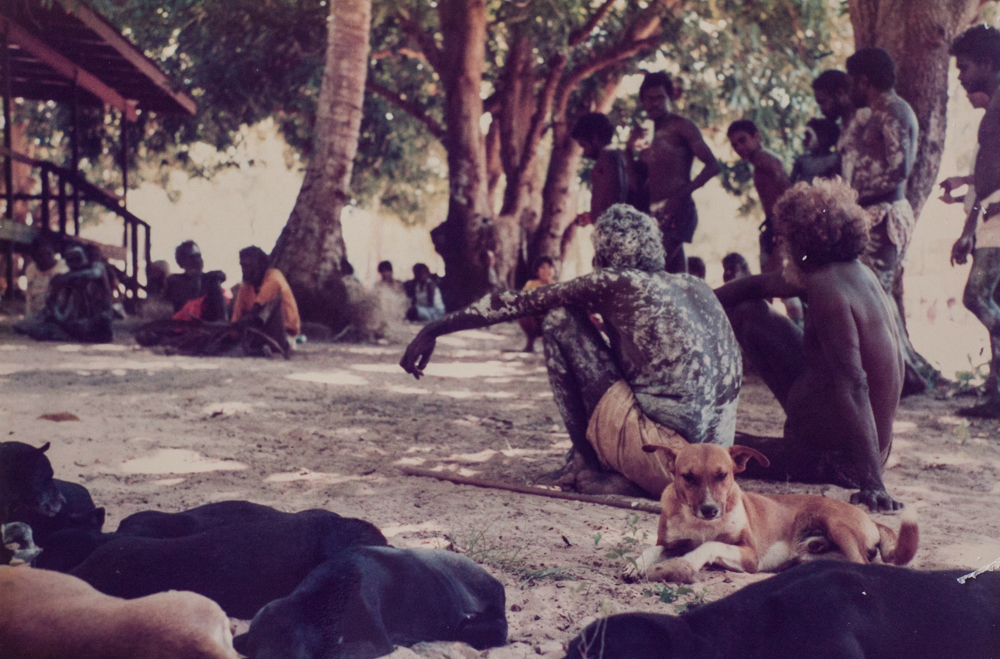Tiwi Culture
Tiwi Culture
TIWI CREATION STORY
In parlingarri (long time ago) the Tiwi were immortal. One day, Wai-ai the wife of Purukupali, met her brother-in-law Japarra in the bush while she was collecting bush tucker and made love with him. She had left her baby son Jinani in the shade, but was away for so long that he died from heatstroke.
Her husband Purukapali, enraged and devastated, fought Japarra, striking him with spears and throwing sticks. Japarra was injured, and flew up to become the moon, always reminding Tiwi of the life and death cycle (full moon, no moon, new moon). Wai-ai became the curlew bird Bima, forever crying out her grief in the dusk.
Purukapali then performed first the Pukumani (funeral) ceremony for his son. He picked up his son and called out, “now my son is gone, we will all have to follow.”
From that day, Tiwi became mortal.
PEDRO TALKING CULTURE
“They are good things – education, knowledge. But, there are two ways.
If young children now days are only looking one way, Tiwi culture will be gone for good.
But we got to save it. It’s real sad if you lose it. – BRIAN FARMER
CEREMONY
The Pukumani and Kulama ceremonies and the creation story remain significant for the Tiwi people. Tiwi culture is different to mainland culture, these ceremonies are part of tiwi lore. When Tiwi have ceremony & funeral, Tiwi singing and Yoi (dancing) comes from lore.
The Pukumani (funeral) ceremony was first performed by Purukapali in parlingarri (long time ago). In the Pukamani ceremony, Tiwi paint themselves in ochre jilamara to disguise themselves from the spirits of the dead, mapurtiti. Tutini poles, painted in natural ochre jilamara, are tiwi markers to show where people will rest for ever.
The first Kulama (mens initiation) ceremony was performed not long after the death of Purukapali, when all animals and birds were still human men and women. Jurrukukuni, a boobook owl man and his wife Pintoma, a barn owl woman performed the ceremony. The white-headed sea eagle Jirakati was the first initiate. When a gold ring forms around the moon during the final stages of the wet season Japarra (the moon man) is performing Kulama. Inside this ring a multitude of star people sing and dance Kulama songs. This is the time to prepare for Kulama, the annual celebration of life. The poisonous Kulama (yam) is prepared to eat and the performance begins for all stages of initiation. When people paint Kulama, they paint large circles representing the glow behind the moon and mens singing ground for ceremony.



Books of Tiwi History & Culture we recommend:
-
-
-
- TIWI: Art / History / Culture by Jennifer Isaacs
A comprehensive volume of Tiwi Art, History & Culture, including an expanded History of Jilamara - The Goddess and the Moon Man: The Sacred Art of the Tiwi Aborigines
A book focussing on the Tiwi creation story, the story of Wai-ai and Purakapali, how man became mortal. - Timothy Cook: Dancing with the Moon Man
A biography of renowned Jilamara artist, Timothy Cook. - Aboriginal Screen-Printed Textiles From Australia’s Top End
Edited by Joanna Barrkman. Published 2020, Fowler Museum at UCLA, Los Angeles. Raelene Miller, Raelene Kerinauia p. 66-89 - Being Tiwi
Edited by Natasha Bullock & Keith Munro. Published 2015, Museum of Contemporary Art Australia, Sydney
- TIWI: Art / History / Culture by Jennifer Isaacs
- Tiwi Art & Artists
Edited by Judith Ryan with contributors. Published 2020 Council of Trustees of Gallery Victoria, Melbourne
-
-


